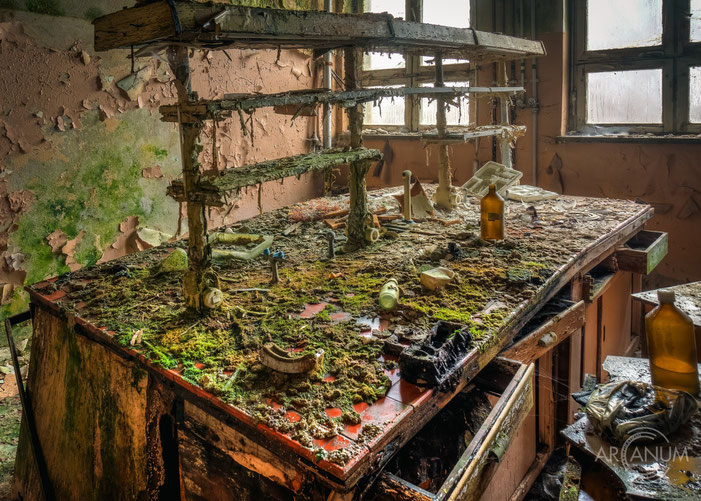Pharmaceutical Company B.
The origins of the company which had their production facilities on these premises date back to a company for laboratory chemicals in
1890.
During World War I, a lot of the company's production resources were required for war production, and presumably until today, parts of the area are
contaminated with the remains of mustard gas grenades.
In 1927, this company merged with another company and began conducting pharmaceutical research.
The company was renamed in 1950 and after the German reunification, the production facilities were relocated, so the entire complex has
been
abandoned since the 1990s.
Do you remember the gallery of the abandoned
distillery? The building in those pictures actually belonged to the original company that started the chemical business in the area as a company for the rectification of
alcohol.
They then expanded their product line to include alcoholic preparations for laboratory use.
As I've said, in 1927, the company started with the pharmaceutical research, and later in the 20th century rose to be one of the three largest
pharmaceutical companies in the GDR (German Democratic Republic).
A nice little anecdote:
Since 1919, the company tried to buy the area on which during the war more than 24.000 grenades per day had been filled with mustard
gas.
In January of 1919, estimations about the remaining amount of combat agents were available. Almost 3.000 metric tons were still there and had to be
destroyed. This was finished around August 1919.
But what worried more, were the 12.000 grenades with production faults that were leaking gas and had been buried on the premises.
The "graves" for the grenades had been fenced in and marked by signs after the war, but the markings and part of the fencings were gone by
1921.
The company was concerned that the buried grenades could harm the compnay - not so much by exploding, but by way of the leaking gas that could react
with air and water in the ground to build sulfuric acid and hydrochloric acid. These acids could cause massive damage to metal pipings and pumps and the company would have to hold the war
ministry liable for any damages, possibly over many decades.
The ministry however referred to a report that counter-checked the company's reports and said that the chlorine gas leaking from chlorine grenades
that had been buried there as well would be neutralizing the threat.
End of the story: The company and its successors have had trouble with the remains of the poison gas until today.
Visited: December 14, 2013, December 15, 2013, February 27, 2016 and February 25, 2017
Location: Undisclosed, Germany
Status: Abandoned / Active
GALLERY UPDATE: Photos added taken on December 15, 2013.
Gallery Update: Tour on February 27, 2016.
Gallery Update: Tour on February 25, 2017.






























































































































































































































